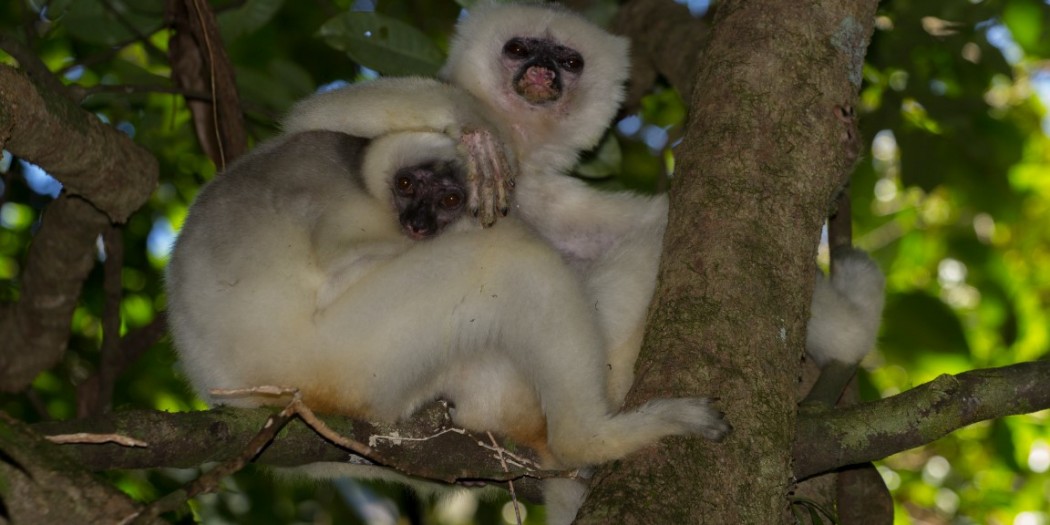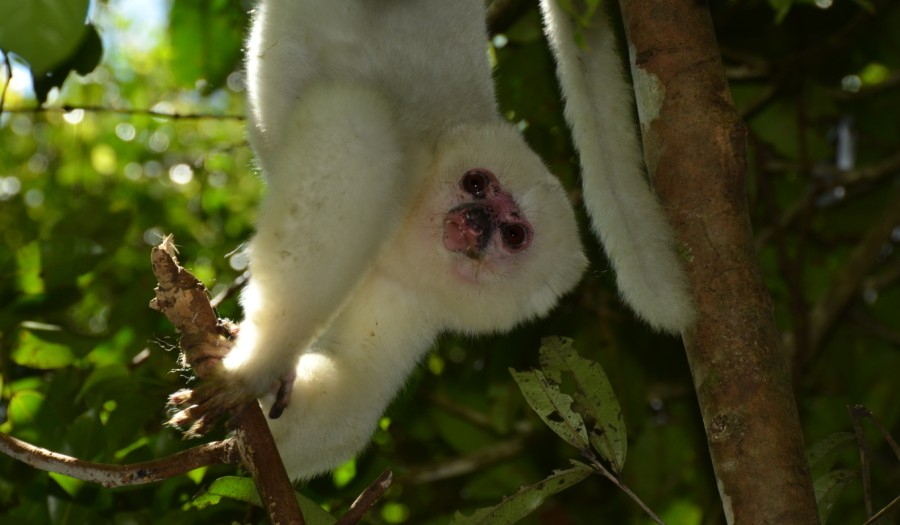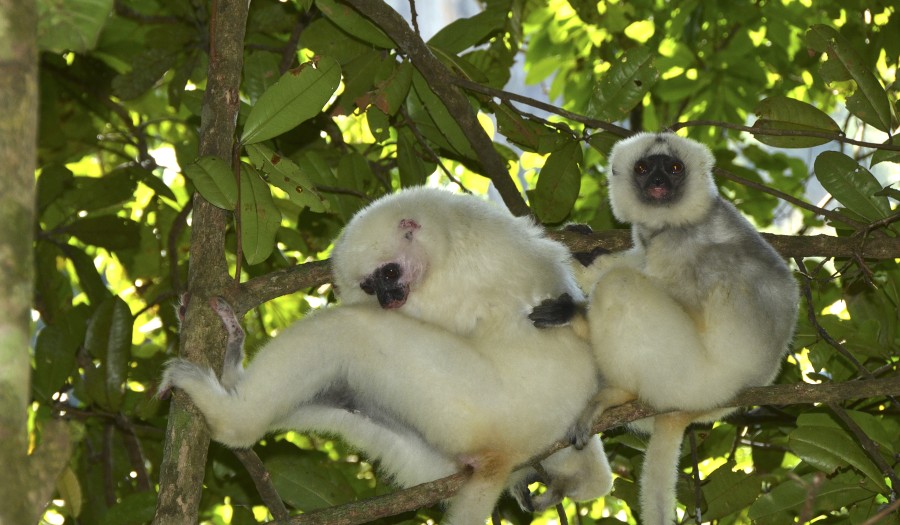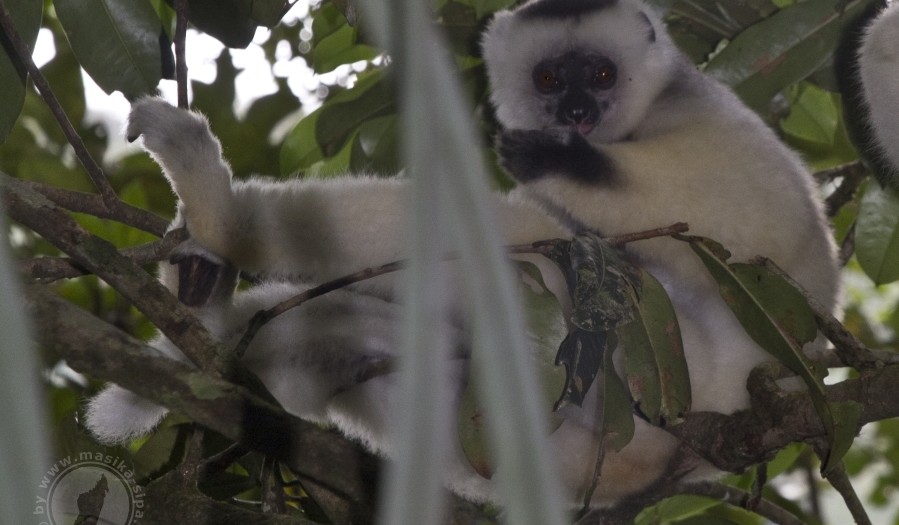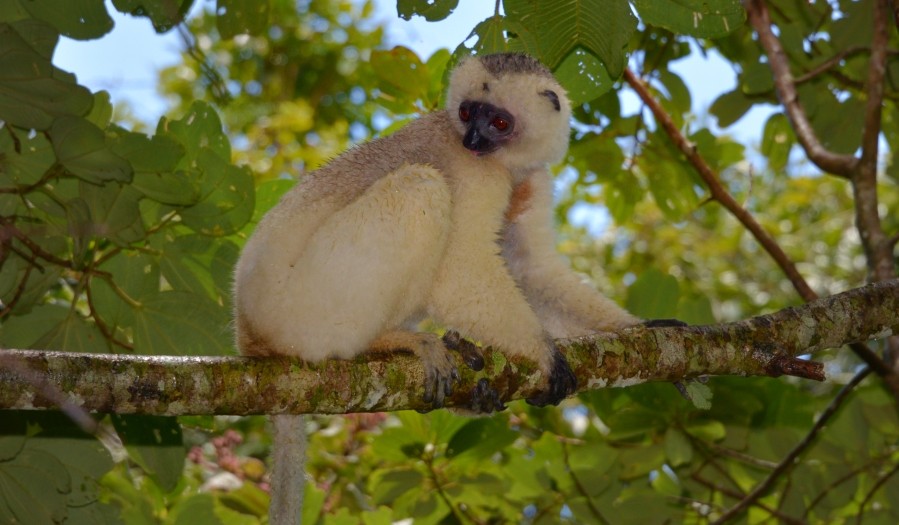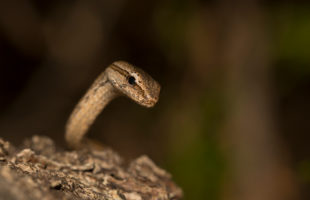The Silky Sifaka (Propithecus candidus) is one of the most beautiful and special lemurs of Madagascar, but also one of the rarest. There are only about 250 sexually mature silk sifakas left in Madagascar, otherwise they do not occur anywhere else in the world. For comparison: In Asia alone there are still around 3000 to 5000 full-grown specimens of tigers considered worthy of protection by the bank, and in addition the protection of these animals is significantly better positioned.
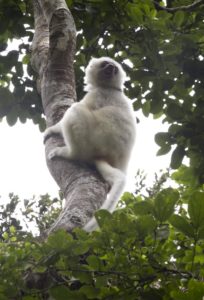
Silky Sifakas were first described in 1871 by Alfred Grandidier, a French zoologist who had observed the animals in the Bay of Antongil. Silky Sifakas reach a size of 93 to 105 cm with a weight of 5 to 6.5 kg. They have long, white fur, sometimes with silver markings on the head, back and limbs. The face, palms and feet are hairless, the skin in these areas is black. In many older animals the black pigmentation becomes less with time and they get pink faces and hands. Because of their white fur, the beautiful orange eyes and the fast, incredibly easy way to move through the tall trees, they have been nicknamed the “Angels of the Forest” in Madagascar. The Malagasy term Simpona, on the other hand, is the native name of the Silky Sifakas.
Silky Sifakas, like most lemurs, are very social animals that live in variable groups of two to nine animals. There are both groups consisting of a single family and groups of several couples and their offspring. Also single males with several females have already been watched. The lead animal is always a female. The sifakas communicate with each other with different sounds, seven of which are currently known. The name-giving “shee-fak” calls, like the very often heard mum and hum calls, serve to keep contact within the group. Hissing “zzuss” calls warn the other animals of prey predators or other stress factors, but are also exchanged between group members after disputes. When large birds roam the treetops, the Silky Sifakas roar loudly through the forest as a warning. If a Sifaka of the group is lost, the animals signal the loss with a howl and try to find the missing group member again. There is also a so-called chatter squeak, which serves as a sign of submission. Surprisingly, there even exists a kind of purring, which is usually emitted during direct encounters with people and probably represents a form of possible threat. Despite the special calls for buzzards and other large birds, so far the only definitely observed predator of the Silky Sifakas is the Fossa.
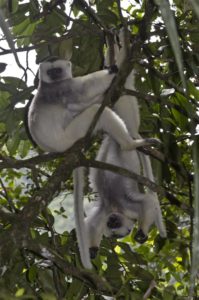
A group of Sifakas moves on the day on the average 700 m far and approximately 500 height meters leaping through the trees, and uses thereby an ancestral area with a size of approximately 0.34 to 0.47 km² in the northeast of Madagascar. The habitat of the Silky Sifakas is very small, although the exact limits of their distribution have not yet been clarified. It extends along a narrow strip of rainforest from Maroantsetra and the Marojejy Mountain to Andapa. At present, the Tsaratanana Mountains are seen as the northern boundary, and the Antainambalana River (part of Makira) as the southern one. However, the animals do not live in the whole area, but live on small, fragmented fragments of rainforest at altitudes of 700 to 1875 m. They live in a very humid, warm climate, the region is one of the rainiest in Madagascar.
The typical day of a Silky Sifaka starts at dusk – if it rains in the morning, the animals simply stay longer in their sleeping positions. Gradually, the family members begin to set out to look for food. Over three quarters of their daily rations consist of seeds and fruits, from time to time they also pick flowers. They use a very wide variety of greens, more than 70 different forage plants have already been identified. Only very rarely bark and soil are on the menu in addition. Besides foraging, the most time-consuming day job of a Silky Sifaka is resting and sleeping in the canopy of the forest – it accounts for up to half of the day. Social behaviour is also an important part of life. They groom each other or play, while they also like to climb down to the ground. Silky Sifakas have a steady daily rhythm, which is rarely interrupted by unusual events.
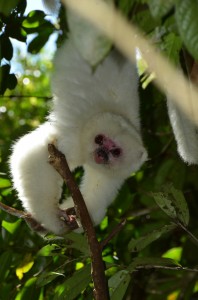
One of such eventus is the mating, which only takes place once a year between November and January, from the beginning to the middle of the rainy season. It is assumed that the females can be successfully mated on only one single day per year. The young are born six months later, in June and July, in the slightly less rainy “dry season“. Per Sifaka female, usually at most every two years a single young is born. At first, the little Silky Sifaka stays on the mother’s belly for some time, until he later dares to rest on her back and is carried through the trees in this way. The babies are not only cared for by their own mothers, but also by the rest of the group.
Male Silky Sifakas often have a large brown spot on the chest. It is formed by scent glands that the males use to mark their territory. They repeatedly set scent markings on trees in the bark of which they have previously scored furrows with a tooth comb (a special device on the lower incisors). Often they cover thereby other scent marks set before by females. But not only the males use scent marks for communication, also the females use genital glands, rubbing their bottom at trees. There are even regular “totem rees”, that are covered by the furrows and smell-brands of the Silky Sifakas.
But the angels of the forest are very much threatened. They are one of Madagascar’s three rarest lemur species and one of the 25 rarest primate species worldwide. They’re not kept in any zoo in the world. Silky Sifakas have been listed on the red list of endangered species for decades as critically endangered which means threatened with extinction.

The efforts to protect these lemurs are still in their infancy in Madagascar. The last retreats of the Silky Sifakas include the Special Reserve Anjanaharibe-South, the neighbouring Marojejy National Park and isolated, smaller areas around Manandriana, Makira and Betaolana. But ever larger parts of officially protected forest areas are also being destroyed, burned down for rice fields, dug up for mining or for cutting valuable tropical timber or simply misused as firewood. Less often the lemurs are hunted because of their flesh, but with such a tiny population every individual counts. Much of the knowledge currently available about the Angels of the Forest is based on more than 14 months of study by Dr. Erik Patel of Duke University in North Carolina, who extensively observed and described the Silky Sifakas.
If you want to experience the last Silky Sifakas on this earth, you should set off for Madagascar as soon as possible. Those who spend a few days in Marojejy National Park and have the right guides can meet the fascinating angels of the forest there with a little luck and at the same time show the local people that the protection itself can bring in money. Time is pressing – who knows how much longer silk sialfakas will be around?
-
- Natural World: Madagascar, lemurs and spies
Tuppence Stone | Great Britain 2011-12 | Documentation | 30 min - Angels of the forest: Silky sifaka lemurs of MadagascarSharon Pieczenik | USA 2010 | Documentation | 45 min
- Natural World: Madagascar, lemurs and spies
 MADAMAGAZINE Your Magazine about Madagascar
MADAMAGAZINE Your Magazine about Madagascar
